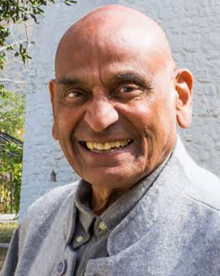Saturdays, 10:00 – 11:30 a.m. CT
August 2 – 23 (4 classes)
 There are many levels of reality subtler than the mind; therefore, science and philosophy cannot comprehend and explain these subtle levels. Searchers in all traditions take recourse to mythology. The whole field of mythology is often understood to be fiction. This view of myths as fiction began to change in the West in the beginning of the twentieth century with the work of people like Mircea Eliade, Joseph Campbell, Carl Jung, Levi Strauss and others.
There are many levels of reality subtler than the mind; therefore, science and philosophy cannot comprehend and explain these subtle levels. Searchers in all traditions take recourse to mythology. The whole field of mythology is often understood to be fiction. This view of myths as fiction began to change in the West in the beginning of the twentieth century with the work of people like Mircea Eliade, Joseph Campbell, Carl Jung, Levi Strauss and others.
Major myths in any society influence the music, visual arts, poetry and all other expressions of the culture. In these classes we will discuss the significance of mythology and the cultural importance of myths, then go through a short introduction to the Hindu gods and goddesses. We will then focus on the ancient Indian myth, “Churning of the Milky Ocean,” exploring its historical background and evolution. Finally, we will delve into the significance and meaning of this myth and see that in reality, it is an exploration of the nature and activity of human consciousness.
See below for the full course syllabus.
Registrants will receive on-demand access to recording(s) that can be viewed for two weeks following the conclusion of the program. Late registrants will receive recording links to all missed sessions.
TS members: $65 • Nonmembers: $80
 Ravi Ravindra, Ph.D., is an author and professor emeritus at Dalhousie University in Halifax, Nova Scotia, where he served as a professor in comparative religion, philosophy, and physics. A lifetime member of the Theosophical Society, Ravi has taught many courses at the School of the Wisdom in Adyar and at the Krotona Institute of Theosophy in Ojai, California. He was a member of the Institute of Advanced Study in Princeton, a fellow of the Indian Institute of Advanced Study in Shimla, and the founding director of the Threshold Award for Integrative Knowledge. For more information visit ravindra.ca.
Ravi Ravindra, Ph.D., is an author and professor emeritus at Dalhousie University in Halifax, Nova Scotia, where he served as a professor in comparative religion, philosophy, and physics. A lifetime member of the Theosophical Society, Ravi has taught many courses at the School of the Wisdom in Adyar and at the Krotona Institute of Theosophy in Ojai, California. He was a member of the Institute of Advanced Study in Princeton, a fellow of the Indian Institute of Advanced Study in Shimla, and the founding director of the Threshold Award for Integrative Knowledge. For more information visit ravindra.ca.
Syllabus
Week 1: The great philosopher Aristotle said, “When philosophy is unable to connect with Truth, one turns to mythology. ... The lover of myths, which are a compact of wonders, is by the same token a lover of wisdom.” The cultural importance of myths has been more and more understood and emphasized since the beginning of the twentieth century, especially in the writings of Mircea Eliade, Joseph Campbell, Carl Jung, Levi Strauss and others. Focusing on Indian mythology, we will have a brief introduction to Brahman (the Vastness beyond being and non-being), the major traditional gods (Brahmā, Vishnu, Shiva) and goddesses (Sarasvati, Lakshmi, Shakti), and their major characteristics and functions.
Week 2: The profound and very ancient myth in the Hindu tradition, called Samundar Manthan or Sagar Manthan and translated as “Churning of the Milky Ocean,” is briefly mentioned in the Rig Veda, but it is elaborated much more in the Puranas and the Mahabharata. We will review the pictorial presentation of this myth, which is also depicted in large form at the main airport in Bangkok, Thailand. It is also the major focus of the famous temple of Angkor Wat in Cambodia.
Week 3: We will explore the inner meaning of this myth which deals with the exploration of human consciousness. The two sides fighting with each other are Daityas and Ādityas. They both have the same Father, Kashyapa, which literally means “Vision.” The Mother of the Daityas is Diti, which means “limited.” The mother of the Ādityas is Aditi which means “unlimited” or “vast.” So, naturally, there is a conflict between the children of limited vision and the children of larger vision. But both sides are needed to explore the ocean of consciousness in order to find Amrita, the nectar of Eternal Life.
Week 4: According to all the spiritual teachings, in principle the entire external cosmos can be mirrored inside us. So, why not the Devil and all the negative energies and attributes associated with him? In this myth, before the emergence of Amrita, the churners of the ocean of consciousness encounter halāhala, poison which could kill all the participants in the struggle. Only Shiva, the Lord of Yoga, is able to swallow halāhala and not be killed. Even in his case, the poison turned his throat blue, leading to a name of Shiva as Nilakantha, the Blue-Throated One.
Program Format
This is a live, interactive online program that will also be recorded. Registrants will receive on-demand access to recording(s) that can be viewed for two weeks following the conclusion of the program.
Join online via a Zoom link that will be emailed upon your registration. Please download Zoom for free at zoom.us/download and test your connection at zoom.us/test. For further information, check out www.theosophical.org/FAQ or email webinars@theosophical.org.


